INTRODUCTION
Having depleted funds by changing our car this year, long-haul birding trips were out. Two very soggy weeks in the western isles and the Scottish Highlands unsuccessfully chasing some of Scotland’s finest was taken in early June, this left us unfulfilled birding-wise. Our preferred option is birding in sandals, shorts and tee-shirts and not thermals, waterproofs and hiking boots. With this in mind we plumped for two weeks in Mallorca at the end of September, although the weather can be mixed the temperatures are still in the mid to high 70°F and the weather tends to be predominately sunny.
Mallorca is a birding location we have visited well over a dozen times over the years. Being a little over 2hrs flying time and a destination several carriers from our local airport fly to every day means flexibility. Although many birding sites we used to visit in the past have disappeared under the developers shovel, there are still enough sites to make Mallorca a worthwhile birding destination, especially if you are new to birding abroad.
We approach our Mallorca birding trips in a very relaxed manner, a typical day would be out early, back for a late breakfast, chill until late afternoon, then a couple of hours birding prior to an evening meal at one of our favourite restaurants. A trip list of 100+ species is achievable for a week’s holiday. 120 species is possible during a 2 week holiday. This requires a more earnest approach; it’s those scarcer less common species that can be targeted during the second week that enlarges the trip list a little.
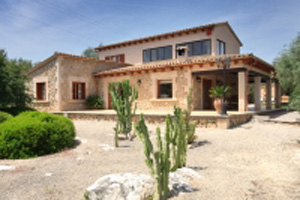 Our preferred approach is to self-cater, we choose a villa from the portfolios of either Villa Select or Villa Plus; both these companies have luxury villas in the north of the island where the majority of the recognised birding sites are located.
Our preferred approach is to self-cater, we choose a villa from the portfolios of either Villa Select or Villa Plus; both these companies have luxury villas in the north of the island where the majority of the recognised birding sites are located.
Our chosen villa this trip was C’an Pericas a villa we have hired before and supplied by Villa Select. This villa is well situated for the 3 main birding locations in the north, The Boquer Valley, the S’Albufera reserve and the Albufereta wetlands. All these are easily reached within 20 minutes’ drive from the villa.
Literature used:
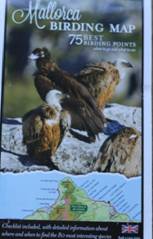


DAY 1
Our day started at 03:30 when we were picked up and taken to the airport by our friend and neighbour Brian. Our flight was a little delayed taking off at nearer 06:30 than the scheduled time of 06:10, other than that the flight was uneventful and we arrived at Palma airport at 09:40 local time. A wait at the carousel of about half an hour saw us pick up our hire car at around 11:00. We then had a wait for about an hour for our chum Trevor (the “wing-commander”) who was coming to join us for the first week from Newcastle.
Greetings completed, we made our way to the Salinas de Levante where we birded for several hours. Eddie’s track was barely passable due to recent rains. Determined to get some birding in we persevered to the first pumping station, but with no sign of the track improving and several near misses of sitting in the oozy black mud we decided to call it a day and return to the car with very very muddy sandals.
Our normal routine on arrival on the island would be to make a bee-line for the villa, drop the cases off and then get some provisions in from the local supermarket, leaving the rest of the day to relax, unwind and plan the next day’s birding. With the north of the island locked down for an international “Iron Man Contest” this was not possible; we were advised not to attempt to reach our villa until late afternoon as all roads north of Inca were closed. With this in mind we stopped at a supermarket in Inca and had a leisurely shop.
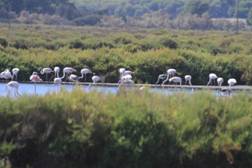 We left for the north of the Island at approximately 16:00 just in time to see squadrons of police motorbikes and cars heading in the opposite direction. We arrived at the villa a little before 17:00 very tired, but glad to be back at a villa where we had had a lovely holiday with our daughter, son-in-law and grandson some 11 years previously.
We left for the north of the Island at approximately 16:00 just in time to see squadrons of police motorbikes and cars heading in the opposite direction. We arrived at the villa a little before 17:00 very tired, but glad to be back at a villa where we had had a lovely holiday with our daughter, son-in-law and grandson some 11 years previously.
Birding on the first day was confined to the Salinas de Levante and only about 100 metres of Eddie’s track. Nevertheless we managed several dozen Greater Flamingo, Greenshank, Ruff, Green Sandpiper, several immature Slender-billed Gull, Water Rail, Cattle Egret, Little Egret, Marsh Harrier, Booted Eagle, Kestrel and Buzzard.
A sandwich and a couple of glasses of Rioja saw the conclusion of our first day and we retired exhausted a little after 10:30pm.
DAY 2
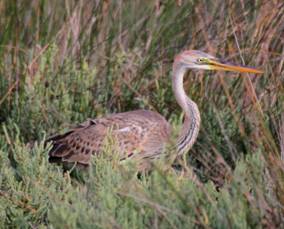 Continuous rain today saw us confined to the villa for most of the day. With the rain relenting late afternoon we took the opportunity to check out the breakwaters on the sea front and visit the new reserve La Gola which is located in Port de Pollença. A very obliging immature Purple Heron was the star bird, giving great views as it fished the margins.
Continuous rain today saw us confined to the villa for most of the day. With the rain relenting late afternoon we took the opportunity to check out the breakwaters on the sea front and visit the new reserve La Gola which is located in Port de Pollença. A very obliging immature Purple Heron was the star bird, giving great views as it fished the margins.
Birds seen on day 2: Shag, Cattle Egret, Grey Heron, Purple Heron, Mallard, Whimbrel, Black-headed Gull, Audouin’s Gull, Northern Wheatear, Spotted Flycatcher, Sardinian Warbler, Blackbird, House Sparrow, Greenfinch, Goldfinch, Wood Pigeon, Collared Dove and Swallow.
DAY 3
With the day dawning warm and sunny we made a bee-line for the Albufera arriving by 09:00. The first thing that hit us was the water levels at both the CIM and Bishop’s hides, much lower than we had ever encountered previously. This impacted on both the number and species of birds on view. It became obvious fairly early into the trip that this trend would be replicated at all the birding sites visited and not just the ones dependent on water. Visits to the Depuradora and the lower fig fields of the Boquer Valley soon reinforced the theme.
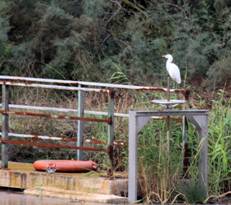 As with our last visit in 2010 Marbled Duck were present in small numbers, a bird you hoped against hope may turn up prior to 2010 and most times you were disappointed. The Tamarisk trees on the far bank of the “Grand Canal” held good numbers of Black-crowned Night Heron clearly visible as they soaked up the warmth of strengthening sun. A lone Osprey stood sentinel on the old pylon half way along the entrance track. The Depuradora also produced very little; just a few loafing gulls and ducks, several Cattle Egret stopped for a drink before flying off. The figs fields also had little of note; several pairs of Raven in playful mood gave some interest. The day concluded with a spectacular electrical storm which started in the late afternoon and continued well into the evening. Whole roasted chicken and crusty bread from the mobile Pullet man washed down with a good Rioja, whilst the sky was being lit up, is a great way to end the day.
As with our last visit in 2010 Marbled Duck were present in small numbers, a bird you hoped against hope may turn up prior to 2010 and most times you were disappointed. The Tamarisk trees on the far bank of the “Grand Canal” held good numbers of Black-crowned Night Heron clearly visible as they soaked up the warmth of strengthening sun. A lone Osprey stood sentinel on the old pylon half way along the entrance track. The Depuradora also produced very little; just a few loafing gulls and ducks, several Cattle Egret stopped for a drink before flying off. The figs fields also had little of note; several pairs of Raven in playful mood gave some interest. The day concluded with a spectacular electrical storm which started in the late afternoon and continued well into the evening. Whole roasted chicken and crusty bread from the mobile Pullet man washed down with a good Rioja, whilst the sky was being lit up, is a great way to end the day.
Birds seen on day 3 Little Grebe, Great-crested Grebe, Black-crowned Night Heron, Cattle, Little and Great Egret, Grey Heron, Gadwall, Teal, Mallard, Shoveller, Marbled Duck, Pochard, Osprey, Kestrel, Red-legged Partridge, Moorhen, Purple Swamphen, Coot, Red-knobbed Coot, Black-winged Stilt, Stone Curlew, Little Ringed Plover, Kentish Plover, Lapwing, Spotted Redshank, Greenshank, Common Sandpiper, Black-headed Gull, Wood Pigeon, Collared Dove, Hoopoe, Swallow, Stonechat, Blue Rock Thrush, Blackbird, Cetti’s Warbler, Zitting Cisticola, Moustached Warbler, Sardinian Warbler, Willow Warbler, Spotted Flycatcher, Pied Flycatcher, Great Tit, House Sparrow, Serin, Greenfinch and Goldfinch.
DAY 4
 Today dawned dull and overcast but still very warm. As we intended to have our evening meal at our favourite fish restaurant in Cala Sant Vicenç we decided to book a table and then check out a couple of sites for Balearic Warbler nearby. Several birds were seen but not long enough for a photo. With the weather closing in and rain looking a possibility we drove back along the bay checking out the breakwaters, normally a good spot for migrating terns, before returning to the villa for a well-earned brunch and a spot of garden birding. Several Sardinian Warbler frequented the garden, a bird I have seen hundreds of times but never managed to get a really good photo of. The evening meal was memorable for the very large plate of steaming mussels devoured by Trevor. Judy sampled a couple and said they were the best mussels she had ever tasted, a fish based Paella completed their meal, mine was escalope of veal.
Today dawned dull and overcast but still very warm. As we intended to have our evening meal at our favourite fish restaurant in Cala Sant Vicenç we decided to book a table and then check out a couple of sites for Balearic Warbler nearby. Several birds were seen but not long enough for a photo. With the weather closing in and rain looking a possibility we drove back along the bay checking out the breakwaters, normally a good spot for migrating terns, before returning to the villa for a well-earned brunch and a spot of garden birding. Several Sardinian Warbler frequented the garden, a bird I have seen hundreds of times but never managed to get a really good photo of. The evening meal was memorable for the very large plate of steaming mussels devoured by Trevor. Judy sampled a couple and said they were the best mussels she had ever tasted, a fish based Paella completed their meal, mine was escalope of veal.
Birds seen on day 4: Shag, Swallow, Robin, Black Redstart, Redstart, Blackbird, Blue Rock Thrush, Spotted Flycatcher, Blackcap, Balearic Warbler, Great Tit, House Sparrow, Chaffinch, Greenfinch and Crossbill.
DAY 5
A dry and bright start to the day, with a strong but warm wind blowing from the south. We decided to check out a new site for us Son Real, this is a site described in the “Birding Tourist’s Guide to Mallorca” as a prime site for sylvia warblers. We attempted to find the Son Bauló part of the site, which is approached through C’an Picafort. Even with our Satnav, which was updated at great expense prior to departure, we ended being instructed to go up a one way street. Abandoning this attempt we went to Son Serra de Marina (aka Son Serra Nou) a site we know well and probably the most reliable site for Thekla Lark. An immature Greater Flamingo and an Oystercatcher (a rare migrant for Majorca) were the pick of the rest. Having brunch at the nearby restaurant we headed for Son Real approaching it from the central car-park. This site is a great example of Mallorcan Garrigue and at the right time of the year it is probably very good. In reality, on our visit the site was extremely quiet with a four hour walk in temperatures in the low 80°F producing very little seen. A walk up the Son Marc valley in the late afternoon also produced very little, making this day probably the quietest birding day we have ever had on Mallorca. A great evening meal at the C’an Cuarassa Restaurant rescued the day.
Birds seen on day 5: Audouin’s Gull, Greater Flamingo, Kentish Plover, Oystercatcher, Wood Pigeon, Collared Dove, Thekla Lark, Grey Wagtail, Whinchat, Blue Rock Thrush, House Sparrow, Greenfinch, and Goldfinch.
DAY 6
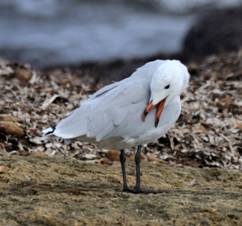
With the “Wing Commander” needing a raptor fix we decided to head towards the vulture station at Mortitx. This site has established itself as a good one for large birds of prey; reintroduced Bonelli’s Eagle and the self-introduced Griffon Vulture have added extra value for this site, without having to travel all the way to Cuber Reservoir. Just 11k up the Lluc road out of Pollença, it is identified by a large sign on the right. We parked on the left, well off the track just before the bottling plant. A steady walk towards Ses Basses produced little in the way of raptors although conditions appeared to be perfect. Several distant Griffon Vulture, a Booted Eagle and an acrobatic Peregrine completed our raptor tally. Trevor continued along the track a small distance and had superb views of a low flying Eleonora’s Falcon. Several passerines were observed in and around the vineyard including a small flock of Serin.
A trip to the Albufereta in late afternoon produced little of note except for a female Montagu’s Harrier a couple of Great Egret, a hunting Osprey and an immature Greater Flamingo.
Birds seen on day 6: Cattle Egret, Little Egret, Great Egret, Grey Heron, Greater Flamingo, Griffon Vulture, Marsh Harrier, Montagu’s Harrier, Booted Eagle, Osprey, Kestrel, Peregrine Falcon, Red-legged Partridge, Greenshank, Audouin’s Gull, Rock Dove, Wood Pigeon, Collared Dove, Hoopoe, Swallow, Stonechat, Blue Rock Thrush, Blackbird, Song Thrush, Zitting Cisticola, Sardinian Warbler, Firecrest, Spotted Flycatcher, Great Tit, Raven, House Sparrow, Chaffinch, Serin, Greenfinch and Goldfinch.
DAY 7
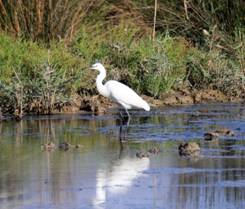 The day started hot and sunny and as this was Trev’s last day it was his choice of birding venues. The Boquer Valley hadn’t been walked so that was Trev’s choice. We stopped off at the breakwaters en route where the only new bird was a Sandwich Tern, the only tern we were to see on the trip. The Boquer was as quiet as we have ever known it except for dozens and dozens of holidaymakers. A trip to the supermarket was required so we left Trev to potter about the valley whilst we shopped. A trip to the rear of the Albufera was made in the late afternoon, the highlight being a murmuration of 10,000 plus Starling doing acrobatics over the reed beds.
The day started hot and sunny and as this was Trev’s last day it was his choice of birding venues. The Boquer Valley hadn’t been walked so that was Trev’s choice. We stopped off at the breakwaters en route where the only new bird was a Sandwich Tern, the only tern we were to see on the trip. The Boquer was as quiet as we have ever known it except for dozens and dozens of holidaymakers. A trip to the supermarket was required so we left Trev to potter about the valley whilst we shopped. A trip to the rear of the Albufera was made in the late afternoon, the highlight being a murmuration of 10,000 plus Starling doing acrobatics over the reed beds.
Birds seen on day 7: Shag, Cattle Egret, Gadwall, Red-crested Pochard, Marsh Harrier, Booted Eagle, Bonelli’s Eagle, Kestrel, Red-legged Partridge, Moorhen, Coot, Audouin’s Gull, Sandwich Tern, Wood Pigeon, Kingfisher, Black Redstart, Stonechat, Northern Wheatear, Blue Rock Thrush, Blackbird, Song Thrush, Sardinian Warbler, Raven, Starling, House Sparrow and Greenfinch.
DAY 8
Today was change-over day, Trevor was leaving us and our near neighbours and friends Brian and Brenda were arriving. Getting to the airport at 09:00 we said our sad good-byes to Trev and welcomed B & B to a very warm Mallorca. We stopped at the “Pullet man” picking up a whole fresh roasted chicken and chips; whilst B & B were unpacking we prepared the salad to accompany the roast chicken lunch. Rested we visited La Gola the small reserve in Port de Pollença in the late afternoon. Much to our amazement the young Purple Heron was still in residence and still just as obliging. A photographic lifer for Brian followed by a second; an Audouin’s Gull snapped at close range on the beach was lifer number 2. Not a bad start!!
Birds seen on day 8: Cormorant, Shag, Purple Heron, Mallard, Booted Eagle, Moorhen, Coot, Common Sandpiper, Black-headed Gull, Audouin’s Gull, Cetti’s Warbler, House Sparrow and Greenfinch.
DAY 9
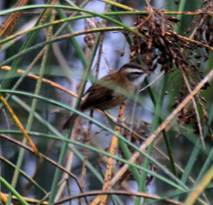 With the dawn sky being lit up by a massive thunderstorm I dragged Jude out of bed to see the free show, I think she approved! So it was with more than a little trepidation that Brian and I left the villa at 07:30 for the Albufera arriving at about 08:00 with just sufficient light to make photography possible. Although Brian is a very keen birder his main love is photographing birds, so the last week of our holiday would be dedicated to getting Brian some half decent photos. A trip around the reserve produced no new birds, but did provide Brian with a couple of photographic lifers; these were Moustached Warbler and Marbled Duck. Several others were new for his European list but he had seen them previously elsewhere. We returned to the villa for a late brunch just in time, as the distant electrical storm seen previously that morning, blew in with a vengeance; deafening thunderclaps followed jagged flashes of lightening, all accompanied by torrential rain and brunch on the back terrace was hastily transferred to the side terrace which was a little more sheltered. As happens many times in the Mediterranean the storm blew itself out after a couple of hours, the sun came out and within an hour of the storm finishing everywhere was dry.
With the dawn sky being lit up by a massive thunderstorm I dragged Jude out of bed to see the free show, I think she approved! So it was with more than a little trepidation that Brian and I left the villa at 07:30 for the Albufera arriving at about 08:00 with just sufficient light to make photography possible. Although Brian is a very keen birder his main love is photographing birds, so the last week of our holiday would be dedicated to getting Brian some half decent photos. A trip around the reserve produced no new birds, but did provide Brian with a couple of photographic lifers; these were Moustached Warbler and Marbled Duck. Several others were new for his European list but he had seen them previously elsewhere. We returned to the villa for a late brunch just in time, as the distant electrical storm seen previously that morning, blew in with a vengeance; deafening thunderclaps followed jagged flashes of lightening, all accompanied by torrential rain and brunch on the back terrace was hastily transferred to the side terrace which was a little more sheltered. As happens many times in the Mediterranean the storm blew itself out after a couple of hours, the sun came out and within an hour of the storm finishing everywhere was dry.
We decided to walk the Son Marc valley in the late afternoon; it was almost devoid of any avian interest and the quietest we had ever known it. Another super meal at the C’an Cuarassa with convivial company rescued the day.
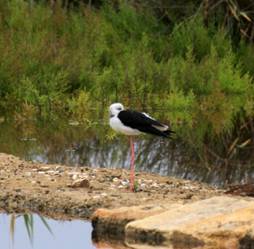 Birds seen on day 9: Night Heron, Cattle Egret, Little Egret, Grey Heron, Teal, Mallard, Shoveller, Marbled Duck, Kestrel, Moorhen, Purple Swamphen, Coot, Red-knobbed Coot, Black-winged Stilt, Stone Curlew, Kentish Plover, Ringed Plover, Spotted Redshank, Greenshank, Black-headed Gull, Wood Pigeon, Collared Dove, Kingfisher, Swallow, Robin, Cetti’s Warbler, Moustached Warbler, Sardinian Warbler, House Sparrow, Chaffinch, Greenfinch and Crossbill.
Birds seen on day 9: Night Heron, Cattle Egret, Little Egret, Grey Heron, Teal, Mallard, Shoveller, Marbled Duck, Kestrel, Moorhen, Purple Swamphen, Coot, Red-knobbed Coot, Black-winged Stilt, Stone Curlew, Kentish Plover, Ringed Plover, Spotted Redshank, Greenshank, Black-headed Gull, Wood Pigeon, Collared Dove, Kingfisher, Swallow, Robin, Cetti’s Warbler, Moustached Warbler, Sardinian Warbler, House Sparrow, Chaffinch, Greenfinch and Crossbill.
DAY 10
Mindful that not all the party were birders we decided to have a touristy day and spent a very pleasant morning in the Cuevas del Drach (Caves of Drach) before having a delightful buffet lunch in one of the many harbour hotels in Porto Cristo.
Birding resumed on our return journey, visiting the small defunct salt works The S’Illot and the Depuradora Water Treatment Works in the late afternoon. Two new ticks for the trip were encountered at the S’Illot, Little Stint and Snipe. Of all the sites visited, this was the only one that lived up to expectations. A chain barrier has been erected at the entrance to the S’Illot reducing the parking to at the most two cars. The track that linked the S’Illot to the Depuradora has now been totally closed. Access has been reducing over several years, but there was always a way round if you knew the area well enough. This has now been closed by barriers at the last remaining access point.
Birds seen on day 10: Cattle Egret, Little Egret, Shelduck, Mallard, Marsh Harrier, Kestrel, Moorhen, Purple Swamphen, Coot, Black-winged Stilt, Little-ringed Plover, Kentish Plover, Little Stint, Snipe, Greenshank, Green Sandpiper, Common Sandpiper, Wood Pigeon, Collared Dove, Kingfisher, Hoopoe, Swallow, Stonechat, Sardinian Warbler, Starling, House Sparrow and Greenfinch.
DAY 11
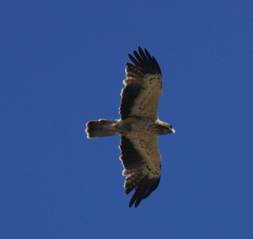 A leisurely start to the day with the luxury of a breakfast at breakfast time. Our first port of call was to the small fish restaurant right on the beach in the little bay in Cala Sant Vicenç in order to secure our table for that night. We then stopped at the woodland opposite the vintage car showroom; we are not aware that this site has a name, although it is a very popular starting point with folk who wish to walk the costal track. As with the S’Illot this site has never been prolific, but it probably produced the species and numbers of birds as previously. This can’t be said for the rest of the sites visited during this trip. A trip to the supermarket to top up on provisions was made and then back to the villa for a restful afternoon. As with the previous day the temperature gauge in the car was registering 32.5 °F, too hot for most of us but an invitation for Brenda to use the pool and soak up some rays. Birding from the shade of the villa’s verandas was our choice. The highlight of the afternoon was a very low flying Booted Eagle and half a dozen or so Eleonora’s Falcon play-fighting high above the villa. The evening meal was not up to expectation, which was unusual for this restaurant.
A leisurely start to the day with the luxury of a breakfast at breakfast time. Our first port of call was to the small fish restaurant right on the beach in the little bay in Cala Sant Vicenç in order to secure our table for that night. We then stopped at the woodland opposite the vintage car showroom; we are not aware that this site has a name, although it is a very popular starting point with folk who wish to walk the costal track. As with the S’Illot this site has never been prolific, but it probably produced the species and numbers of birds as previously. This can’t be said for the rest of the sites visited during this trip. A trip to the supermarket to top up on provisions was made and then back to the villa for a restful afternoon. As with the previous day the temperature gauge in the car was registering 32.5 °F, too hot for most of us but an invitation for Brenda to use the pool and soak up some rays. Birding from the shade of the villa’s verandas was our choice. The highlight of the afternoon was a very low flying Booted Eagle and half a dozen or so Eleonora’s Falcon play-fighting high above the villa. The evening meal was not up to expectation, which was unusual for this restaurant.
Birds seen on day 11: Booted Eagle, Eleonora’s Falcon, Kestrel, Wood Pigeon, Collared Dove, Swallow, Robin, Black Redstart, Blue Rock Thrush, Blackbird, Sardinian Warbler, Cetti’s Warbler, Firecrest, Pied Flycatcher, Raven, Starling, House Sparrow, Chaffinch and Crossbill.
DAY 12
 Another glorious start to the day and our last visit to the Albufera. With Brian still looking to increase his photographic portfolio, the Albufera is the best bet as it is the only site where bird hides allow you to get close enough for decent photography – the very skittish nature of the Mallorcan birds makes open photography very challenging.
Another glorious start to the day and our last visit to the Albufera. With Brian still looking to increase his photographic portfolio, the Albufera is the best bet as it is the only site where bird hides allow you to get close enough for decent photography – the very skittish nature of the Mallorcan birds makes open photography very challenging.
Armed with our early morning pass we had the walk into the reserve to ourselves. It wasn’t until we reached “Englishman’s Bridge” that we saw another birder. Several Black-crowned Night Heron were evident in their day roosts along the access road and 17 Stone Curlew were counted in the field next to CIM hide. A couple of Moustached Warbler gave fleeting glimpses in the spiked rush beneath the main bridge over the “Grand Canal” challenging Brian to get a half decent photo. All of the birds observed this trip had been seen during our previous visit.
Birds seen on day 12: Great-crested Grebe, Night Heron, Cattle Egret, Little Egret, Grey Heron, Gadwall Teal, Mallard, Shoveller, Marsh Harrier, Kestrel, Moorhen, Purple Swamphen, Coot, Red-knobbed Coot, Black-winged Stilt, Stone Curlew, Kentish Plover, Ringed Plover, Little Stint, Dunlin, Snipe, Spotted Redshank, Greenshank, Green Sandpiper, Yellow-legged Gull, Zitting Cisticola, Sardinian Warbler, Starling, House Sparrow, Greenfinch and Goldfinch.
DAY 13
 With Brian keen to add Thekla Lark to his portfolio and Son Serra de Marina the most reliable site to get them, it was decided that we would visit this site first today. These birds can be found very near the public car park which is adjacent to a beach-side bar that sells Bacon Baguettes using thick cut bacon – just the job for a late breakfast. This site contains a brackish lake, just beyond the beach, which we feel is a habitat that could provide more than it actually does; a skulking Water Rail was a new bird for the venue. Although the Thekla Larkproved troublesome, Brian managed some acceptable photos, making breakfast even tastier. A second brief visit to Son Real produced even less than the first visit which was very disappointing. We rested during the hottest part of the day. We spotted a beautiful Swallowtail butterfly before leaving the villa for the back of the Albufera by late afternoon. Again as with the previous visits little was seen, although Brian took the opportunity to photograph one of the several Zitting Cisticola flying around the mound.
With Brian keen to add Thekla Lark to his portfolio and Son Serra de Marina the most reliable site to get them, it was decided that we would visit this site first today. These birds can be found very near the public car park which is adjacent to a beach-side bar that sells Bacon Baguettes using thick cut bacon – just the job for a late breakfast. This site contains a brackish lake, just beyond the beach, which we feel is a habitat that could provide more than it actually does; a skulking Water Rail was a new bird for the venue. Although the Thekla Larkproved troublesome, Brian managed some acceptable photos, making breakfast even tastier. A second brief visit to Son Real produced even less than the first visit which was very disappointing. We rested during the hottest part of the day. We spotted a beautiful Swallowtail butterfly before leaving the villa for the back of the Albufera by late afternoon. Again as with the previous visits little was seen, although Brian took the opportunity to photograph one of the several Zitting Cisticola flying around the mound.
Birds seen on day 13: Cormorant, Cattle Egret, Great Egret, Grey Heron, Mallard, Shoveller, Marsh Harrier, Osprey, Eleonora’s Falcon, Kestrel, Purple Swamphen, Red-knobbed Coot, Greenshank, Thekla Lark, Swallow, Stonechat, Sardinian Warbler, Raven, Starling, House Sparrow and Goldfinch.
DAY 14
The last day of our trip: as Brian & Brenda hadn’t walked the Boquer Valley we decided it would be a nice way to conclude the holiday. A chance to see some birds and a walk through “Pine Walk” stopping off at one of the seafront restaurants for lunch. You will probably have concluded that meals form almost as big a part to our holidays as the birds. Having completed a walk through the Boquer, Brian and I strolled through Postage Stamp Wood which was even more devoid of avian interest than the Boquer which was pretty poor. After our lunch and in desperation, we drove along the “Llenaire Road” to the river bridge hoping to see birds coming to drink in the heat of a very hot afternoon. A stroll along the road adjacent to the river produced nothing more than a solitary Little Egret. Finally admitting defeat we returned to our villa to relax for the rest of the day and pack, ready for our departure from the villa at 08:00 the next morning.
CONCLUSION
Mallorca was as quiet as we had ever known it. Some said the very low water table was a contributory factor, others said it was the hot, settled weather conditions allowing the birds to bypass the island and carry on to Africa. Our total for the trip was 92; nothing new or exceptional, but after 16 visits that’s to be expected.
Bird Species List with distribution notes
Pat & Judy Hayes
